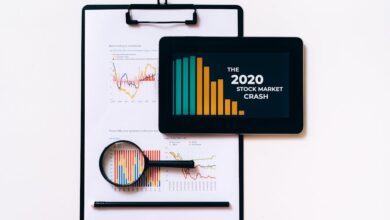Riding the Economic Wave: Recognizing Recession Signals and Strategic Responses for Today’s Investors

In an ever-fluctuating economic landscape, the specter of recession looms large, influencing not only financial markets but also the daily lives of individuals and businesses alike. Understanding the early warning signs of an economic downturn is crucial for both investors and policymakers, as it allows for proactive measures to mitigate potential damage. This article delves into the intricate web of factors associated with recessions, exploring how they impact various sectors of the economy and alter consumer behavior. We will examine effective investment strategies during challenging times, the critical role of government stimulus in fostering recovery, and the implications for global trade and supply chains. Moreover, by reflecting on lessons learned from past recessions, we aim to equip businesses with the knowledge necessary to prepare for and navigate these tumultuous periods. Join us as we unpack the complexities of economic recessions and provide insights that can help individuals and organizations thrive even in the face of adversity.
- 1. **Identifying the Red Flags: Early Warning Signs of an Economic Recession**
- 2. **Navigating the Downturn: Investing Strategies for Recessionary Times**
1. **Identifying the Red Flags: Early Warning Signs of an Economic Recession**
Economic recessions often unfold over time, but certain early warning signs can signal their approach. Identifying these red flags is crucial for businesses, investors, and policymakers alike.
One of the most reliable indicators is a decline in consumer confidence. When consumers feel uncertain about their financial future, they tend to reduce spending, which can lead to a slowdown in economic growth. A significant drop in retail sales, especially in discretionary spending, further supports this notion.
Another key sign is a rise in unemployment rates. As companies begin to anticipate lower demand, they may initiate layoffs or halt hiring, leading to increased joblessness. Additionally, an uptick in initial unemployment claims can serve as an early warning signal of economic distress.
Changes in manufacturing activity also provide critical insights. A decrease in manufacturing output, often measured by indices like the Purchasing Managers' Index (PMI), indicates that businesses are producing less in response to waning demand. Similarly, a slowdown in new orders can foreshadow declining production levels and potential layoffs.
Interest rates play a pivotal role as well. Central banks may raise rates to combat inflation, but if these rates become too high, they can stifle borrowing and investment, leading to an economic slowdown. Conversely, a sudden drop in rates might indicate an attempt to stimulate an economy already showing signs of weakness.
Finally, stock market volatility can be a precursor to a recession. Significant declines in stock prices often reflect investor pessimism about future corporate earnings and overall economic health.
By closely monitoring these indicators—consumer confidence, unemployment rates, manufacturing activity, interest rates, and stock market trends—stakeholders can better prepare for the potential onset of a recession, allowing for more informed decision-making in uncertain times.
Economic recessions are often characterized by a decline in economic activity, which can be identified through various early warning signs. These signs may include a significant drop in consumer confidence, rising unemployment rates, decreasing retail sales, and a contraction in manufacturing output. Monitoring these indicators can provide valuable insights into the potential for an impending recession.
The impact of recessions on different sectors of the economy can vary widely. The consumer goods sector typically experiences a decline as spending tightens, while luxury goods and non-essential services are hit particularly hard. Conversely, sectors such as healthcare and discount retailers may see increased demand as consumers prioritize essential goods and services. Real estate markets often slow down, leading to decreased property values and reduced construction activity.
Investing during a recession requires a strategic approach. Investors may consider shifting their portfolios toward defensive stocks—companies that provide essential products and services that remain in demand during downturns. Additionally, bonds may become an attractive option as they generally provide stability and a fixed income during volatile periods. Diversification and a focus on long-term value can help mitigate risks associated with economic uncertainty.
Government stimulus plays a crucial role in mitigating the effects of recessions. Fiscal policies, such as increased government spending and tax relief, aim to boost consumer spending and support struggling businesses. Monetary policy, including lower interest rates and quantitative easing, can stimulate economic activity by making borrowing cheaper. The effectiveness of these measures often depends on the depth and duration of the recession, as well as the underlying economic conditions.
During economic downturns, consumer behavior typically shifts towards more cautious spending. Consumers may prioritize essential purchases, seek discounts, and reduce discretionary spending. This behavioral change can lead businesses to adapt their marketing strategies, focusing on value and affordability to attract cost-conscious customers.
Recessions also have significant implications for global trade and supply chains. Economic contractions can lead to a reduction in demand for imported goods, impacting countries reliant on exports. Supply chains may face disruptions as companies scale back production, leading to delays and increased costs. This interconnectedness underscores the importance of resilience and flexibility in global trade networks.
Lessons learned from past recessions, such as the Great Depression and the 2008 financial crisis, are particularly relevant today. These events highlight the importance of financial prudence, the need for diversified investments, and the role of effective government intervention. Businesses that proactively prepare for economic downturns—by building cash reserves, diversifying revenue streams, and maintaining strong customer relationships—are more likely to survive and thrive in challenging times. By understanding the signs of a recession and its multifaceted impacts, both individuals and businesses can navigate economic uncertainty more effectively.
2. **Navigating the Downturn: Investing Strategies for Recessionary Times**
Investing during a recession can be daunting, yet strategic approaches can help mitigate risks and potentially yield positive returns. One primary strategy is to focus on defensive stocks, which are companies that provide essential goods and services regardless of economic conditions. Sectors such as utilities, healthcare, and consumer staples tend to perform better during downturns as they cater to basic needs.
Another strategy involves diversifying investment portfolios. By spreading investments across different asset classes—such as stocks, bonds, and commodities—investors can reduce their exposure to any single economic sector, thereby minimizing risk. Additionally, incorporating fixed-income securities, such as government bonds, can provide a safer haven during turbulent times, as they typically offer more stability.
Investors may also consider dividend-paying stocks. These companies often have strong cash flows and a history of returning profits to shareholders, making them more resilient during economic slowdowns. Reinvesting dividends can further enhance long-term returns and provide a buffer against market volatility.
Moreover, maintaining a cash reserve can be a prudent strategy. Having liquid assets allows investors to take advantage of buying opportunities that may arise during market dips. This approach requires a disciplined mindset to resist panic selling and instead focus on long-term investment goals.
Finally, it is essential to stay informed and adapt to changing market conditions. Regularly reviewing investment strategies and being responsive to economic indicators can help investors navigate the complexities of a recession. By remaining cautious yet opportunistic, investors can better position themselves to weather economic downturns and emerge stronger when the market recovers.
In conclusion, understanding the early warning signs of an economic recession is crucial for individuals, businesses, and policymakers alike. By recognizing these red flags, stakeholders can take proactive measures to mitigate potential negative impacts. The effects of a recession are multifaceted, influencing various sectors of the economy, altering consumer behavior, and disrupting global trade and supply chains. However, history has shown us that recessions are not insurmountable challenges; they present opportunities for strategic investment and innovation.
Government stimulus plays a vital role in softening the blow of economic downturns, providing essential support to those in need and fostering recovery. By analyzing past recessions, we can glean valuable lessons that inform our responses to future economic challenges. Businesses that prepare for downturns by diversifying their strategies and maintaining financial resilience are more likely to survive and thrive in the long term.
Ultimately, while recessions may be a natural part of the economic cycle, awareness and preparedness can significantly alleviate their impact. By adopting prudent investment strategies and remaining agile in the face of change, we can navigate these turbulent times with greater confidence and resilience.





